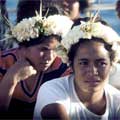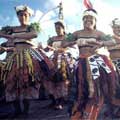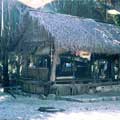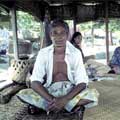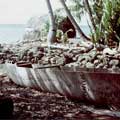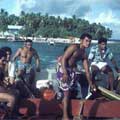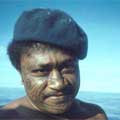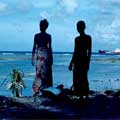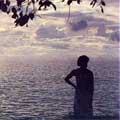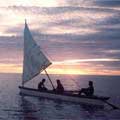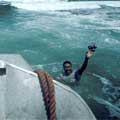Ship’s Stories: South Pacific Charter
While the Transglobe Expedition Team are in Antarctica, the crew of the Benjamin Bowring are facing a very different climate in the South Pacific, where the Benjamin Bowring is on charter to the New Zealand government and acting as an inter-island supply ship for all the small islands around Samoa and Fiji.
The charter will hopefully provide some of the very necessary income needed to cover the Expedition’s running costs. The following is an account of the charter written by Antony Bowring, the expedition’s Marine Co-ordinator.
The main purpose of the charter is to provide a sea link between Apia (in Western Samoa) and the Tokelau Islands which lie 300 miles to the north of Apia. The islands are looked after by the New Zealand Ministry of Foreign Affairs and, apart from ourselves have no other direct contact with the outside world except by radio telephone. The islands comprise three atolls: Fakaofo, Nukunono and Atafu. We were to make regular trips from Apia to these islands with cargos of essential supplies as well as carry passengers. As the Tokelau run is not a full time operation, Pacific Forum (the charter managers) are able to utilise the ship to provide a similar service to other islands and these included Funafuti and Tarawa (in the Tuvalu and Kiribati groups).
Two days before departing from Cape Town, we were joined by three new members of the ship’s company, Ralph Bygott, 2nd Officer, recently employed by P & O, and a replacement for Dave Peck, who broke his leg and will be out of action for some considerable time, Mick Jones, 3rd Officer, and Captain Les Davis of The Bowring Steamship Company Ltd. who was to take the ship to the Pacific. And so, on the 27th March with a full complement, we sailed from Cape Town on the start of a seven week voyage to Suva in Fiji. Ahead of us lay a 10,000 mile journey from the South Atlantic, across the Indian and into the middle of the Pacific Oceans. We had some idea of what was expected of us, and as we journeyed across the oceans, our imaginations worked upon us and influenced our speculation of what was in store. We knew, for instance, that we would be carrying passengers but what sort of standard they would expect was very much a mystery. We concluded that for us to mimic the QE 2 would be going too far, but for our own self respect, we should make every effort to be worthy of at least one star. The only cabins that would be suitable for passengers required some attention and Terry Kenchington, the bosun, together with Martin Weymouth, undertook the redecorating, while Eddie Pike, our carpenter, knocked furniture back into shape.
During the crossing of the Indian Ocean, Ken Cameron, Chief Engineer, became uncomfortably aware that one of the main engine cylinder liners was becoming very worn. It would be vital to have the machinery working properly and a decision was made to anchor off Thursday Island, North Australia, at the entrance to the Torres Strait. While at anchor, four miles offshore, the engineers, Ken, Mark Williams and Howard Willson worked into the night for four consecutive days to make the necessary repairs. The rest of us spent this time, removing all our own stores from the holds and restacking them in every available space, for the holds had to be absolutely empty for our charterers; and with a three year supply of tinned and dried stores taking up valuable hold space, we were hard pushed to find alternative space.
When all was done, and the Torres Strait Pilot had come aboard, we weighed anchor and started to make our way through the reefs and shallows which divide Australia from New Guinea. The wind was fresh from the South East and the sea was lively. We passed through most of the reefs during the night and in the light of the full moon, the lines of breaking water on the reefs were clearly visible. Had the main engine developed further problems during this passage, we could have been in serious trouble. As it was, all went well and we cleared the Strait and entered the Pacific. The Pilot left us by launch off Port Moresby and, with freshening winds, we started the last leg of our voyage.
“When the wind blows the cradle will rock” – and so we did. The ship was rolling with complete disregard to comfort. The blue expanse around us was peppered with white horses. Spray covered the whole ship with a film of clammy salt and the air was breathlessly hot and damp. Occasional showers, sometimes torrential, cooled the air, but despite this, there was a general feeling of lethargy on board. The delights of Fiji were becoming more and more tempting although as we covered the last miles, the days seemed to get longer and longer.
Finally, on the morning of the 14th May, we arrived outside the narrow entrance between the reefs that protect Suva harbour. A small and very rusty ship lay awkwardly on the reef surrounded by breaking water – reminding us of the need for cautious navigation in these island waters. The wind had dropped, the sea was calm and the island of Viti Levu lay ahead of us – a series of hills covered in a thick coat of palm trees. The early morning rays of sunshine gave a tint of gold to the small cumulus clouds which reflected in the still waters. A plume of smoke rose vertically from among the palms some distance inland and there was a subtle smell of healthy, abundant vegetation in the air.
No sooner had we berthed than we were visited by officials from Customs, Port Health, Immigration; by surveyors, our agents, chandlers, laundrymen, stevedores and the manager of Pacific Forum Line (the company responsible for the management of the charter on behalf of the New Zealand government). We were also visited by the resident High Commissioners of New Zealand and Tuvalu (or Ellice Islands) who were both anxious to see the accommodation, cargo spaces and facilities for deck passengers. My anxiety must have shown as I guided them about the ship. I had no idea what standard they were expecting and I was only too aware of the many imperfections that surrounded us. The tour was carried out with as much optimism as I could muster and with as little lingering as was decently possible. Surprisingly, the result was more than satisfying, They considered that the Benjamin Bowring was in much better shape than they had expected or, indeed, were used to. Previous vessels had been veritable rust buckets compared to ours and had not infrequently ended their days on the reefs.
After the surveyors had done their inspection, the cargo loading began and continued through the heat of the day and all through the night. Cyrus Balaporia, Chief Officer, and Ralph Bygott were responsible for keeping a constant watch on the loading and ensuring that goods were loaded in the right order. David Hicks was promoted to Chief Steward and was made responsible for looking after the well-being of our passengers and to help him, we signed on a charming Fijian called Mika Kanakanaira who was to take on some of the extra domestic chores. Although Mika spoke excellent English his accent was sometimes difficult to understand. He called David “Debbie”.
In the early afternoon on 15th May, we departed from Suva and made our way past the flat atolls in the Fijian group which are only conspicuous by their abundant growth of palm trees which stand out against the horizon. When we were clear of the islands we were back into the open sea and bound for Apia. The weather was still poor and the lively sea continued to cause us discomfort. Mike Jones (our recently recruited South African 3rd Officer) was ill. He was looking very run down and feeling terrible. It was not sea sickness although we were not sure what else it could be. During the three day voyage, he showed no signs of improvement and when we arrived in Apia, we got him off to hospital. The doctor in Apia also had difficulty in diagnosing the illness and insisted that Mike should stay ashore and not travel on the ship while he was put on a course of drugs and remained under observation.
Pacific Forum have their head office in Apia and so we were able to meet those who would be looking after us. We discussed all the finer details of the charter party with them and, as the first day in Apia was a Sunday, we were taken for a picnic by the staff. It was terrible weather and we were rained upon for the entire duration of our outing. When we returned to the ship, the rain stopped and loading began. For the whole night, the ship was alive with the sounds of winches, fork-lift trucks and stevedores. As soon as the hold was full, we loaded a small amount of deck cargo and then hoisted aboard two 20-ft aluminium boats which would be used to unload the cargo in the Tokelau Islands. By the evening of our second day, we were fully loaded and had only to embark the passengers before departing.
In the descending gloom of twilight, the passengers arrived. They were a colourful group of islanders with enormous quantities of luggage. Our cabins were all prepared for them with fresh bed linen, towels, soap and Gideon’s Bibles. The corridors were lined with bundles of strange possesions and there was an air of total chaos.
Up on the bridge all was quiet. Captain Davis, Cyrus and the pilot were all prepared for departure. On deck, we were ready at our stations to cast off the lines. A crowd of islanders congregated on the jetty to see off their friends and relations who were taking a breather from the struggle below decks. Before long, we were silently gliding out of the harbour and into the dark ocean.
The journey to the first of the Tokelau Islands was only 300 miles which we reached in thirty-one hours. This atoll has the rather unusual name of Fakaofo. Until dawn, we lay eight miles offshore and as the sun’s first rays brightened the sky, we moved close into the reef which surrounded the main island. Despite our being only 300 yards off the reef, the seabed deepened very rapidly and beneath us were 200 fathoms of dark water which precluded a safe anchorage. A narrow passage which had once been blasted out of the reef, provided the only small boat access to the island. On our arrival, islanders came out to us in their small boats and dug-out canoes. We unloaded our two barges and before long the islanders were busy unloading their part of our cargo. They were a colourful crowd, all wearing lava-lavas (a garment worn around the wait like a towel) and some with head bands made from freshly picked frangipane flowers. It was not long before ‘Debbie” had such a sweet smelling and picturesque garland which he sported jauntily upon his head and never removed until evening when the blooms were hanging limply from his brow. The passengers who were destined for other islands started to emerge on deck. They brought their sleeping mats with them and, having found shaded spots, stretched out and slumbered peacefully as work got under way. In the very hot weather, it is not uncommon practice to hose down the wooden decks each day. Whilst engaged in this task, Terry Kenchington’s hose flushed out an elderly and very skinny gentleman from under a bench. The old man suddenly appeared from his resting place, dripping wet and climbed into Ralph’s hammock which completely enveloped him. After a brief struggle, he emerged yet again and took refuge on the deck below, where he found suitable berth in a coil of rope.
These islands had not received any stores or fuel since February due to a shortage of available shipping suitable for such work. The islanders were therefore anxious to land everything as quickly as possible. With this in mind, they decided to save time by using the barges for the dry cargo while the 45 gallon drums of Kerosene were lowered into the sea and the many volunteers swam them ashore. So good are they at swimming, that they sometimes go fishing without a boat. They take their lines with them and swim out past the reef drop their lines and hover around until they have a good catch before returning to dry land.
A permanent watch had to be maintained on the bridge to ensure that we kept a safe distance off the reef and, at the same time, that we were not drifting too far off. The engineers were on stand-by to repair any faults that might develop with the winches and they were also fully occupied in keeping up with their heavy maintenance programme which ran the risk of being neglected with all the additional use of ship’s equipment. The excessive heat made work on deck uncomfortable and the accommodation (which is specially insulated for the polar climate) was no better. Cuts and scratches tended to go septic at an alarmingly swift rate and it was not uncommon for us to feel very run down despite our consumption of salt tablets.
In spite of our labours, we all had a chance to go ashore. Fakaofo (like Nukunono and Atafu) was very small and every available space was taken up with dwellings. These dwellings were simple structures made from timber and palm fronds. The buildings consisted of vertical poles supporting a roof of plaited palm leaves and a slightly raised floor. As there were no walls around the buildings, it was easy for the inhabitants to observe us as we strolled around. The whole village was built under a canopy of palm and breadfruit trees which filtered the sun’s glare and radiated a cool green light on the world beneath. There was a surprising silence in the air which at first made us talk in whispers amongst ourselves. The whole effect was reminiscent of being in a huge cathedral. As we strolled along the broad avenues which separate the dwellings, chickens and small, dark pigs as well as many children shyly observed us from a safe distance. Most of the adults were reclining under their plaited roofs and, as we passed, they greeted us. On several occasions, we were beckoned over to join them in drinking the juice from coconuts which were obviously in no short quantity. It was fascinating to watch as they stripped the outer shell of the nuts with their teeth. When the kernel was unwrapped, it was opened with a swift hack from a small but very sharp machete. Before long our stomachs were sagging under the weight of several pints of ‘milk’ and although we would have loved to refuse more, it was difficult to do so without seeming rude. There is no trade on the islands apart from the harvesting of very small amounts of copra and the fishing which is for domestic supply only. There seemed to be very little happening except for the labours on board the ship and at the landing place. However they pride themselves, with justification, on their handicrafts which include the most exquisite basket work and wood carving which is reputed to be the best from all the many islands in the Pacific. One or two of the elder men on the islands produce very finely made models of their fishing canoes, which reflect their skill in producing the full scale version. As there are no trees of sufficient size to make a dug-out from one trunk, they carve out separate sections and stitch them together with a stout cord made from palm leaves. The seams and holes are filled and plugged with a thick gum made from the sap of the same trees. The result is a sturdy craft of some 25 feet overall length with out-rigger and sail.
As we wandered about the islands, we all experienced different encounters which would take up many pages to narrate. Some saw traditional Polynesian dancing, some investigated the coral reefs and watched the countless colourful fish darting hither and thither, some enjoyed the company of the island people and joined them in consuming freshly caught fish and carefully fermented coconut juice: but the style of the islands is changing. The canoes are giving way to rugged aluminium speed boats with large outboards which are doubtless very practical as long as fuel is available. Electricity and even deep freezers are available on the islands. The perfect summing up came from an islander himself who got his lava-lava caught in a ring bolt on the ship and turned to Eddie Pike and said, “That’s the trouble with these damn lava-lavas, they keep coming undone!”
Our travels take us to several islands. Owing to the nature of the work, we get little time off. Sickness is not uncommon. Mick Jones was sent home to Cape Town to recuperate. Martin Weymouth was admitted to an island hospital after a fall on deck. Flies and mosquitoes are everywhere and their bites take ages to heal… ‘

